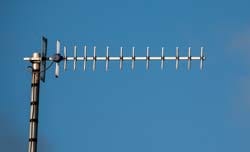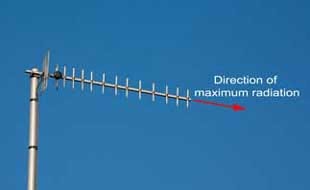Yagi Antenna Theory: Yagi Antenna Basics
Understanding some of the basics of Yagi antenna theory can help with their use, operation and design.
Home » Antennas & Propagation » this page
Yagi antenna includes:
Yagi antenna
Yagi antenna theory & calculations
Yagi antenna gain & directivity
Yagi feed impedance & matching
In depth Yagi antenna theory can be complicated, but a basic understanding of how a Yagi antenna works can provide sufficient insight for many applications and for basic design purposes.
In understanding the basic Yagi antenna theory, the different elements of the Yagi antenna react in a complex and interrelated way.

Yagi antenna theory - the basics
One of the major keys to understanding Yagi theory is a knowledge of the phases of the currents flowing in the different elements of the antenna.
The parasitic elements of the Yagi antenna operate by re-radiating their signals in a slightly different phase to that of the driven element. In this way the signal is reinforced in some directions and cancelled out in others.
As the additional antenna elements in the Yagi are not directly driven but pick up power from the driven element, these additional elements are referred to as parasitic elements.

One limitation of the design of Yagi anennas is that the power in these additional elements is not directly driven. Accordingly the amplitude and phase of the induced current cannot be completely controlled. It is dependent upon their length and the spacing between them and the dipole or driven element.
This means that it is not possible to obtain complete cancellation in one direction. Nevertheless it is still possible to obtain a high degree of reinforcement in one direction and have a high level of gain, and also have a high degree of cancellation in another to provide a good front to back ratio. The Yagi antenna is able to provide very useful levels of gain and front to back ratios.

showing reflector longer and directors shorter than driven element)
To obtain the required phase shift an element can be made either inductive or capacitive. Each type of reactance has a different effect.
- Inductive: If the parasitic element is made inductive it is found that the induced currents are in such a phase that they reflect the power away from the parasitic element. This causes the RF antenna to radiate more power in the opposite direction to this form of parasitic element. An element that does this is called a reflector.
The element can be made inductive by tuning it below resonance. This can be done by physically adding some inductance in the form of a coil, or more commonly by making it longer than the resonant length. Generally it is made about 5% longer than the driven element as this saves cost and keeps the element mechanically as one piece which makes it cheaper and stronger.
Only one reflector is ever used. The addition of further reflectors makes no noticeable difference. - Capacitive: If the parasitic element is made capacitive it will be found that the induced currents are in such a phase that they direct the power radiated by the whole antenna in the direction of the parasitic element. An element which does this is called a director. It can be made capacitive tuning it above resonance. This can be done by physically adding some capacitance to the element in the form of a capacitor, or more commonly by making it about 5% shorter than the driven element.
It is found that the addition of further directors increases the directivity of the antenna, increasing the gain and reducing the beamwidth. The length of successive directors is reduced slightly.
To summarise the theory behind the directors and reflectors of a Yagi antenna:

 Written by Ian Poole .
Written by Ian Poole .
Experienced electronics engineer and author.
More Antenna & Propagation Topics:
EM waves
Radio propagation
Ionospheric propagation
Ground wave
Meteor scatter
Tropospheric propagation
Antenna basics
Cubical quad
Dipole
Discone
Ferrite rod
Log periodic antenna
Parabolic reflector antenna
Phased array antennas
Vertical antennas
Yagi
Antenna grounding
Installation guidelines
TV antennas
Coax cable
Waveguide
VSWR
Antenna baluns
MIMO
Return to Antennas & Propagation menu . . .




